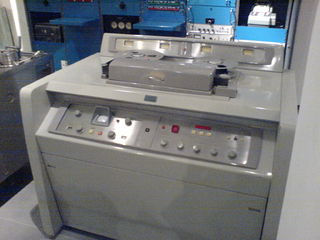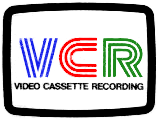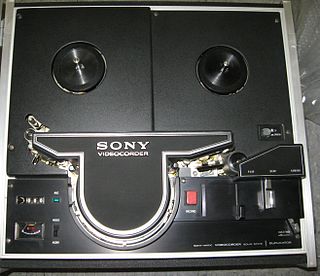Related Research Articles

VHS is a standard for consumer-level analog video recording on tape cassettes invented in 1976 by the Victor Company of Japan and was the competitor to the ill-fated Sony Betamax system.

The Compact Cassette, also commonly called a cassette tape, audio cassette, or simply tape or cassette, is an analog magnetic tape recording format for audio recording and playback. Invented by Lou Ottens and his team at the Dutch company Philips in 1963, Compact Cassettes come in two forms, either containing content as a prerecorded cassette (Musicassette), or as a fully recordable "blank" cassette. Both forms have two sides and are reversible by the user. Although other tape cassette formats have also existed—for example the Microcassette—the generic term cassette tape is normally used to refer to the Compact Cassette because of its ubiquity.

Digital Audio Tape is a signal recording and playback medium developed by Sony and introduced in 1987. In appearance it is similar to a Compact Cassette, using 3.81 mm / 0.15" magnetic tape enclosed in a protective shell, but is roughly half the size at 73 mm × 54 mm × 10.5 mm. The recording is digital rather than analog. DAT can record at sampling rates equal to, as well as higher and lower than a CD at 16 bits quantization. If a comparable digital source is copied without returning to the analogue domain, then the DAT will produce an exact clone, unlike other digital media such as Digital Compact Cassette or non-Hi-MD MiniDisc, both of which use a lossy data-reduction system.

An audio tape recorder, also known as a tape deck, tape player or tape machine or simply a tape recorder, is a sound recording and reproduction device that records and plays back sounds usually using magnetic tape for storage. In its present-day form, it records a fluctuating signal by moving the tape across a tape head that polarizes the magnetic domains in the tape in proportion to the audio signal. Tape-recording devices include the reel-to-reel tape deck and the cassette deck, which uses a cassette for storage.

Videotape is magnetic tape used for storing video and usually sound in addition. Information stored can be in the form of either an analog or digital signal. Videotape is used in both video tape recorders (VTRs) and, more commonly, videocassette recorders (VCRs) and camcorders. Videotapes have also been used for storing scientific or medical data, such as the data produced by an electrocardiogram.

Ampex Data Systems Corporation is an American electronics company founded in 1944 by Alexander M. Poniatoff as a spin-off of Dalmo-Victor. The name AMPEX is a portmanteau, created by its founder, which stands for Alexander M. Poniatoff Excellence. Ampex operates as Ampex Data Systems Corporation, a subsidiary of Delta Information Systems, and consists of two business units. The Silicon Valley unit, known internally as Ampex Data Systems (ADS), manufactures digital data storage systems capable of functioning in harsh environments. The Colorado Springs, Colorado, unit, referred to as Ampex Intelligent Systems (AIS), serves as a laboratory and hub for the company's line of industrial control systems, cyber security products and services and its artificial intelligence/machine learning technology.

Reel-to-reel audio tape recording, also called open-reel recording, is magnetic tape audio recording in which the recording tape is spooled between reels. To prepare for use, the supply reel containing the tape is placed on a spindle or hub. The end of the tape is manually pulled from the reel, threaded through mechanical guides and over a tape head assembly, and attached by friction to the hub of the second, initially empty takeup reel. Reel-to-reel systems use tape that is 1⁄4, 1⁄2, 1, or 2 inches wide, which normally moves at 3+3⁄4, 7+1⁄2, 15 or 30 inches per second. Domestic consumer machines almost always used 1⁄4 inch (6.35 mm) or narrower tape and many offered slower speeds such as 1+7⁄8 inches per second (4.762 cm/s). All standard tape speeds are derived as a binary submultiple of 30 inches per second.
Betacam is a family of half-inch professional videocassette products developed by Sony in 1982. In colloquial use, "Betacam" singly is often used to refer to a Betacam camcorder, a Betacam tape, a Betacam video recorder or the format itself.

A video tape recorder (VTR) is a tape recorder designed to record and playback video and audio material from magnetic tape. The early VTRs were open-reel devices that record on individual reels of 2-inch-wide (5.08 cm) tape. They were used in television studios, serving as a replacement for motion picture film stock and making recording for television applications cheaper and quicker. Beginning in 1963, videotape machines made instant replay during televised sporting events possible. Improved formats, in which the tape was contained inside a videocassette, were introduced around 1969; the machines which play them are called videocassette recorders.

Video Cassette Recording (VCR) is an early domestic analog recording format designed by Philips. It was the first successful consumer-level home videocassette recorder (VCR) system. Later variants included the VCR-LP and Super Video (SVR) formats.

The 8mm video format refers informally to three related videocassette formats. These are the original Video8 format and its improved successor Hi8, as well as a more recent digital recording format known as Digital8. Their user base consisted mainly of amateur camcorder users, although they also saw important use in the professional television production field.
The Digital Audio Stationary Head or DASH standard is a reel-to-reel, digital audio tape format introduced by Sony in early 1982 for high-quality multitrack studio recording and mastering, as an alternative to analog recording methods. DASH is capable of recording two channels of audio on a quarter-inch tape, and 24 or 48 tracks on 1⁄2-inch-wide (13 mm) tape on open reels of up to 14 inches. The data is recorded on the tape linearly, with a stationary recording head, as opposed to the DAT format, where data is recorded helically with a rotating head, in the same manner as a VCR. The audio data is encoded as linear PCM and boasts strong cyclic redundancy check (CRC) error correction, allowing the tape to be physically edited with a razor blade as analog tape would, e.g. by cutting and splicing, and played back with no loss of signal. In a two-track DASH recorder, the digital data is recorded onto the tape across nine data tracks: eight for the digital audio data and one for the CRC data; there is also provision for two linear analog cue tracks and one additional linear analog track dedicated to recording time code.

U-matic is an analogue recording videocassette format first shown by Sony in prototype in October 1969, and introduced to the market in September 1971. It was among the first video formats to contain the videotape inside a cassette, as opposed to the various reel-to-reel or open-reel formats of the time. The videotape is 3⁄4 in (19 mm) wide, so the format is often known as "three-quarter-inch" or simply "three-quarter", compared to open reel videotape formats in use, such as 1 in (25 mm) type C videotape and 2 in (51 mm) quadruplex videotape.

1–inch Type C is a professional reel-to-reel analog recording helical scan videotape format co-developed and introduced by Ampex and Sony in 1976. It became the replacement in the professional video and broadcast television industries for the then-incumbent 2–inch quadruplex videotape open-reel format. Additionally, it replaced the unsuccessful type A format, also invented by Ampex, and, primarily in mainland Europe, it supplemented the type B format, invented by the Fernseh division of Bosch, but it was replaced by type C format also there.

1–inch type B VTR is a reel-to-reel analog recording video tape format developed by the Bosch Fernseh division of Bosch in Germany in 1976. The magnetic tape format became the broadcasting standard in continental Europe, but adoption was limited in the United States and United Kingdom, where the Type C videotape VTR met with greater success.

Sony HDVS is a range of high-definition video equipment developed in the 1980s to support an early analog high-definition television system thought to be the broadcast television systems that would be in use today. The line included professional video cameras, video monitors and linear video editing systems.

Betamovie is the brand name for a range of consumer grade camcorders developed by Sony for the Betamax format. By "camcorder" is understood a single unit comprising a video camera and a video recorder.

EIAJ-1 was a standard for video tape recorders (VTRs) developed by the Electronic Industries Association of Japan with the cooperation and assistance of several Japanese electronics manufacturers in 1969. It was the first standardized format for industrial/non-broadcast VTRs using a helical scan system employing open reel tape. Previously, each manufacturer of machines in this market used a different proprietary format, with differing tape speeds, scanner drum diameters, bias frequencies, tracking head placement, and so on, although most used 1/2" wide tape. As a result, video tapes recorded on one make and/or model of VTR could only be interchanged with other machines using that specific format, hampering compatibility. For example, a reel of tape recorded on a Panasonic machine would not play on a Sony machine, and vice versa. The EIAJ-1 standard ended this incompatibility, giving those manufacturers a standardized format, interchangeable with almost all VTRs subsequently brought to market around that time. The format offered black-and-white video recording and playback on 1/2″ magnetic tape on a 7″ diameter open reel, with portable units using smaller 5″ diameter reels.

A videocassette recorder (VCR) or video recorder is an electromechanical device that records analog audio and analog video from broadcast television or other source on a removable, magnetic tape videocassette, and can play back the recording. Use of a VCR to record a television program to play back at a more convenient time is commonly referred to as timeshifting. VCRs can also play back prerecorded tapes. In the 1980s and 1990s, prerecorded videotapes were widely available for purchase and rental, and blank tapes were sold to make recordings.
From 1963 to 1970, Ampex manufactured several models of VTR 2-inch helical VTRs, capable of recording and playing back analog black and white video. Recording employed non-segmented helical scanning, with one wrap of the tape around the video head drum being a little more than 180 degrees, using two video heads. One video drum rotation time was two fields of video. The units had two audio tracks recorded on the top edge of the tape, with a control track recorded on the tape's bottom edge. The 2-inch-wide video tape used was one mil thick. The VTRs were mostly used by industrial companies, educational institutions, and a few for in-flight entertainment.
References
- 1 2 Derene, Glenn (2008-03-20). "The 10 Video Formats HD DVD Will Meet in Heaven". Popular Mechanics . Retrieved 2008-03-25.
- 1 2 "Sony CV-2000D First Consumer Videocorder". LabGuy's World. 2005-01-09. Retrieved 2008-03-27.
- ↑ Sony.com History
- ↑ "Trends in the Semiconductor Industry: 1970s". Semiconductor History Museum of Japan. Archived from the original on 27 June 2019. Retrieved 27 June 2019.
- ↑ Hara, Yoshiko. "Sony: electronics ordered 'to go'". EETimes . Retrieved 2008-03-25.
- 1 2 "The Sony CV-2000 Reel-to-Reel Video Recorder". Retro Thing. November 2005. Retrieved 2008-03-27.
- ↑ "Presenting a home Videocorder from Sony," Sony Corporation of America, undated (c1967) brochure.
- ↑ smecc.org Sony CV series video